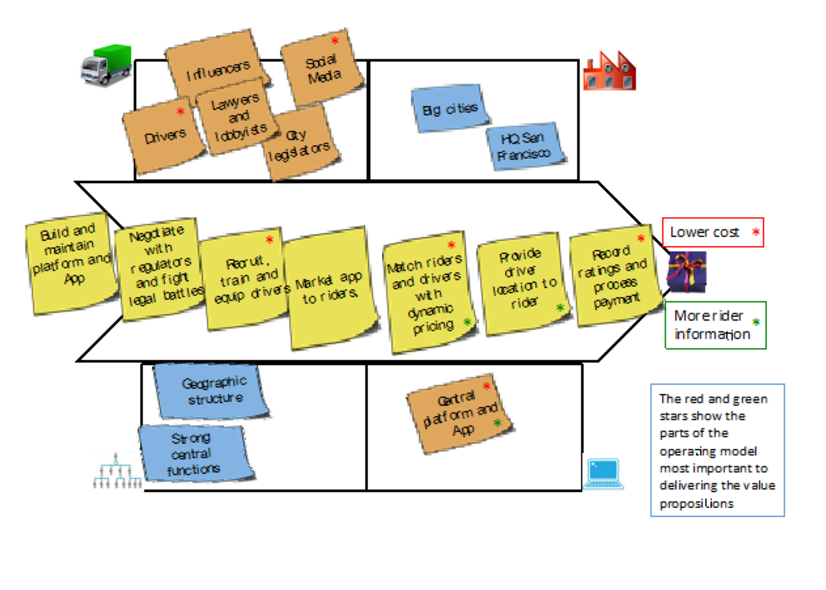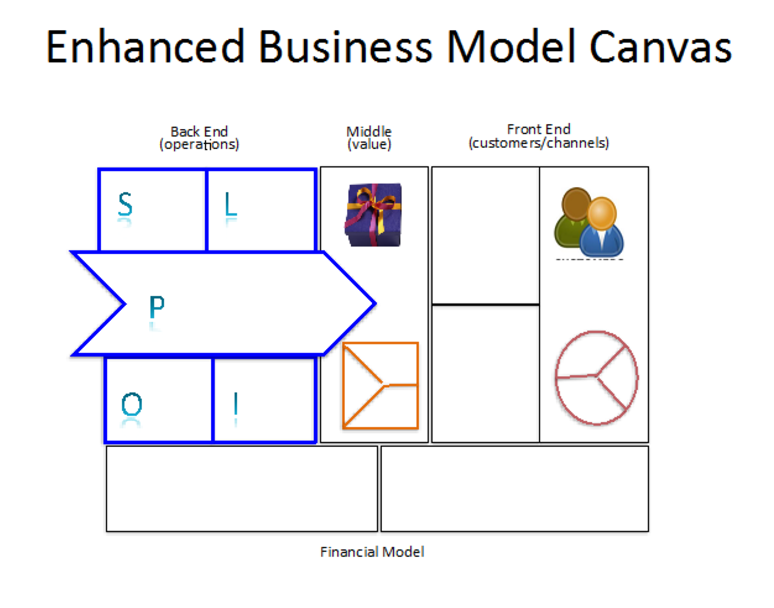 Those working on operational excellence are typically focused on optimisation, waste elimination, capacity utilization, process redesign and other operational challenges. This focus can lead to a lack of business perspective. How can operational excellence professionals keep the business in mind while making operational improvements?
Those working on operational excellence are typically focused on optimisation, waste elimination, capacity utilization, process redesign and other operational challenges. This focus can lead to a lack of business perspective. How can operational excellence professionals keep the business in mind while making operational improvements?
The business model canvas is one widely used tool. By laying out the main elements of the business in a simple canvas, operational excellence professionals can make sure that their work is always connected with the needs of the business.
There are only nine elements, and the canvas makes it easy to see the connections between them. Not surprisingly Business Model Generation, Alex Osterwalder and Yves Pigneur’s book that launched the business model canvas, has sold over one million copies.
Given its popularity, you need to be brave to suggest that the business model canvas can be improved. But there are weak or less well developed parts of the canvas. The left-hand side of the canvas – Key Partners, Key Activities, Key Resources – is one area that has had limited attention, in terms of further development, since the canvas was published nearly 10 years ago. This is the part of the canvas that is of most interest to those working on operational excellence. Moreover, the term operating model has gained usage not only in consulting companies but also in organisations making change. A target operating model or TOM is a description of the future state that the organisation aims to change into.
So is it possible to combine operating model thinking with the Business Model Canvas, and so give those working on operations a more powerful way of seeing the bigger picture?
Fortunately, the term operating model has also been defined in a canvas – the Operating Model Canvas (see www.operatingmodelcanvas.com or the book Operating Model Canvas published March 2017). The Operating Model Canvas divides an operating model into five core elements:
- Processes – the work that needs to be done to deliver the value proposition
- Organisation – the people who do the work, how they are organized
- Location – where the work is done
- Information – what information solutions and databases are needed to support the work
- Suppliers – what external organisations are needed to support the work
The five core elements make up the mnemonic POLIS (see exhibit).
Here is an example of Uber’s operating model. Because the operating model canvas is typically used in management workshops with post-it notes to capture thoughts, the Uber model is presented as a series of thoughts on post-it notes. The yellow post-its in the center depict the core work steps that enable Uber to deliver a taxi service at lower cost and with more information in the hands of the traveller. The blue and brown post-its describe Uber’s choices about location, suppliers, organisation and information.
There is a sixth element in the Operating Model Canvas – Management system – the planning, budgeting, target setting, performance management, risk management, governance and continuous improvement processes needed to run the organisation. This element underpins all the other elements and hence is not considered a core part of the canvas, rather an additional sixth element. It is not displayed in the Uber example, but is sometimes added as an additional box along the bottom of the visual. The full mnemonic of all six elements is POLISM.
If we take the five core elements of the Operating Model Canvas and consider where they would fit into the Business Model Canvas, we can see that Processes can replace Key Activities and Suppliers can replace Key Partners. The other elements – Organisation, Information and Location – are either additional items or link to Key Resources. So the Operating Model Canvas is an alternative way of presenting the left-hand side of the Business Model Canvas. If we combine the two canvases – we can create an Enhanced Business Model Canvas.
So why is it better to replace three elements with five: it increases the total from nine to eleven, which adds complexity? First, the five elements refer to recognisable parts of an organisation in everyday language. Of course the five elements still need to be explained and understood. But, because they refer to things managers recognise, they are easier to understand and to remember, than Key Activities, Key Partners and Key Resources.
Second, the visual display places “Processes” (the middle arrow in the display) at the centre of the operational side of the canvas. This focuses attention where it should be focused: on the work that needs to be done to deliver the value proposition. The other four elements are positioned around this central focus signalling that they exist to support, facilitate and improve the core work steps of the “value delivery chain”.
Third, the enhanced canvas gives space to two critical topics that are often overlooked in the traditional Business Model Canvas – information and location. As digital technology evolves, information and information systems are increasingly replacing people, are increasingly central to the value proposition and are increasingly critical to operational excellence. Giving them focused attention is becoming essential. Also, as businesses globalize, people work at home and activities are executed in the cloud, location choices are fundamental to operational effectiveness. Adding a location box to the Business Model Canvas ensures that this topic gets appropriate attention.
The Enhanced Business Model Canvas helps managers keep in touch with the business when they are buried in operational challenges. It helps managers see the bigger picture. The Operating Model Canvas is also useful on its own. It can be used to capture on one page the purpose and main operational choices of an internal function or activity: it can be used when the Business Model Canvas feels less relevant. Together the two canvases are powerful ways of keeping operations aligned with business objectives and strategy.
To learn more about the Operating Model Canvas, go to www.operatingmodelcanvas.comor buy the book Operating Model Canvas, by Andrew Campbell, Mikel Gutierrez and Mark Lancelott, Van Haren Publishing, 2017.
(C) Andrew Campbell – Originally published in Op Ex Magazine
Andrew Campbell has been Director of Ashridge Strategic Management Centre, part of Ashridge Business School, since 1987. Previously, he was on the faculty of London Business School and a consultant at McKinsey & Co. He is an expert on business strategy with a particular bias towards organisation design and operating model work. He has authored more than 10 books, including the classic texts “Strategy for the Corporate Level” and “Designing Effective Organisations”. His latest book (March 2017) is “Operating Model Canvas”. He has published 10 articles in the Harvard Business Review, including the popular “What is wrong with strategy?” and “Do you have a well designed organisation?”
Andrew directs executive courses, advises a range of companies, leads research projects and is a non-executive director of Sonae. His executive courses include Advanced Organisation Design and Designing Operating Models. His latest research is on “operating models” (see blog at www.ashridgeonoperatingmodels.com and book website http://www.operatingmodelcanvas.com. Andrew features in YouTube video collections under the search terms “Corporate Level Strategy”, “Operating Models” and “Collaborative Working”. Connect with him on LinkedIn.



